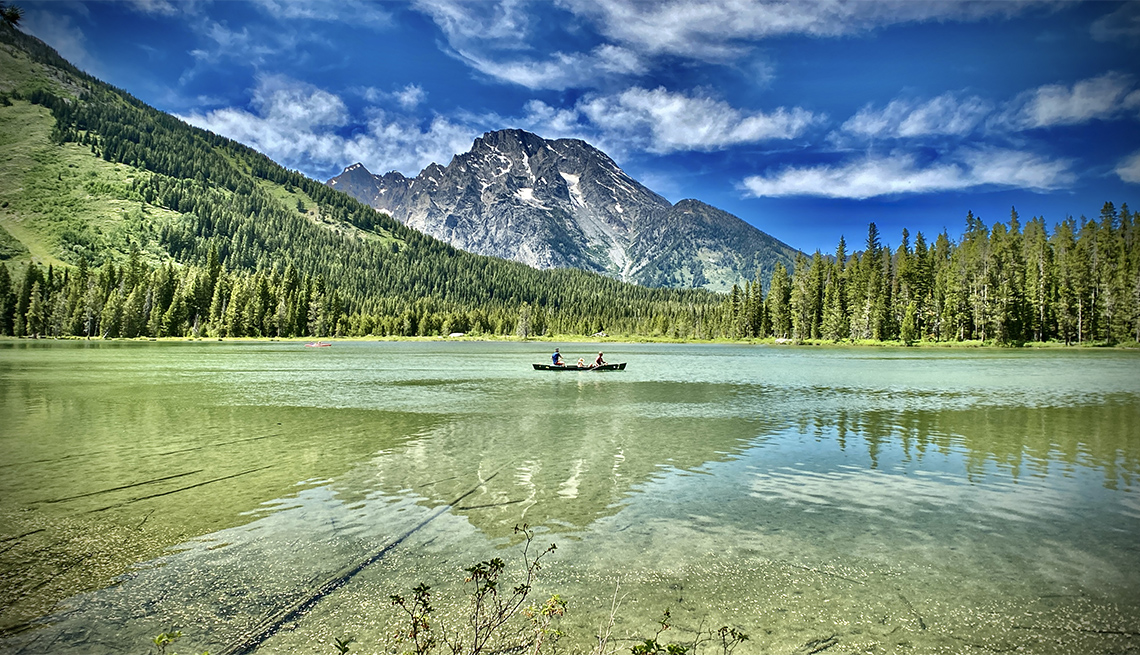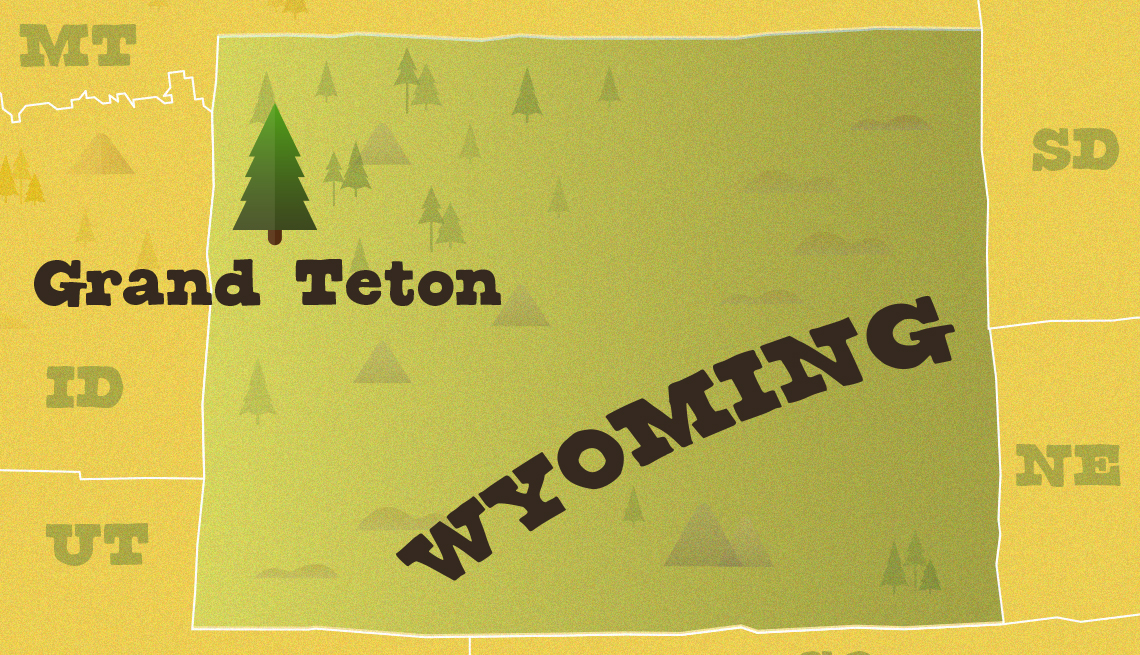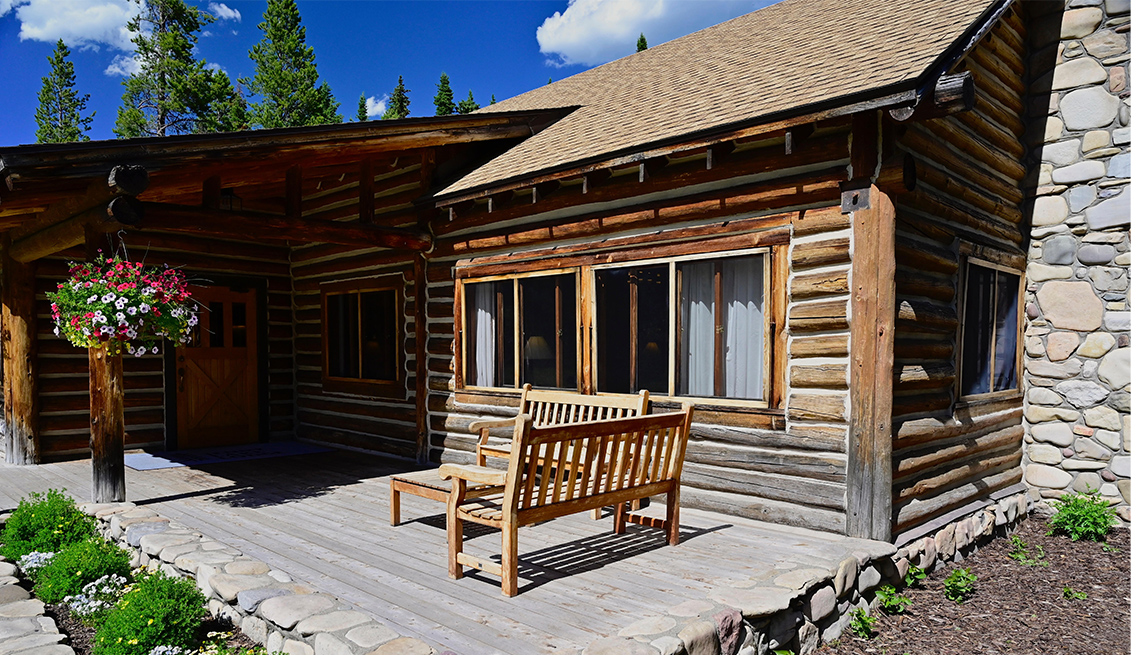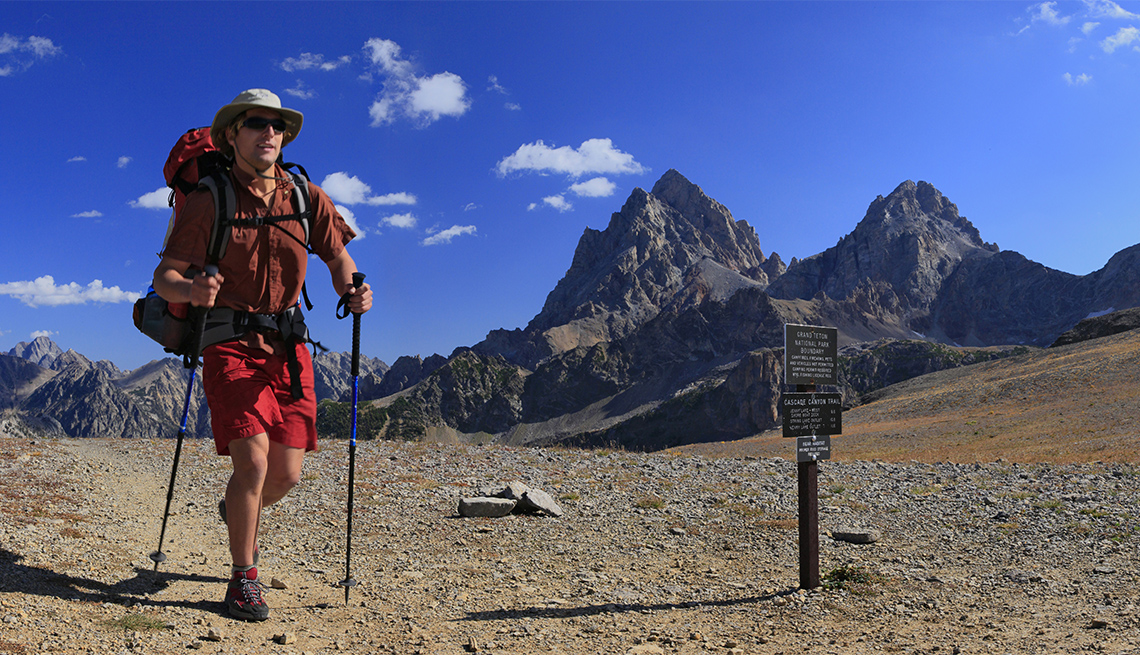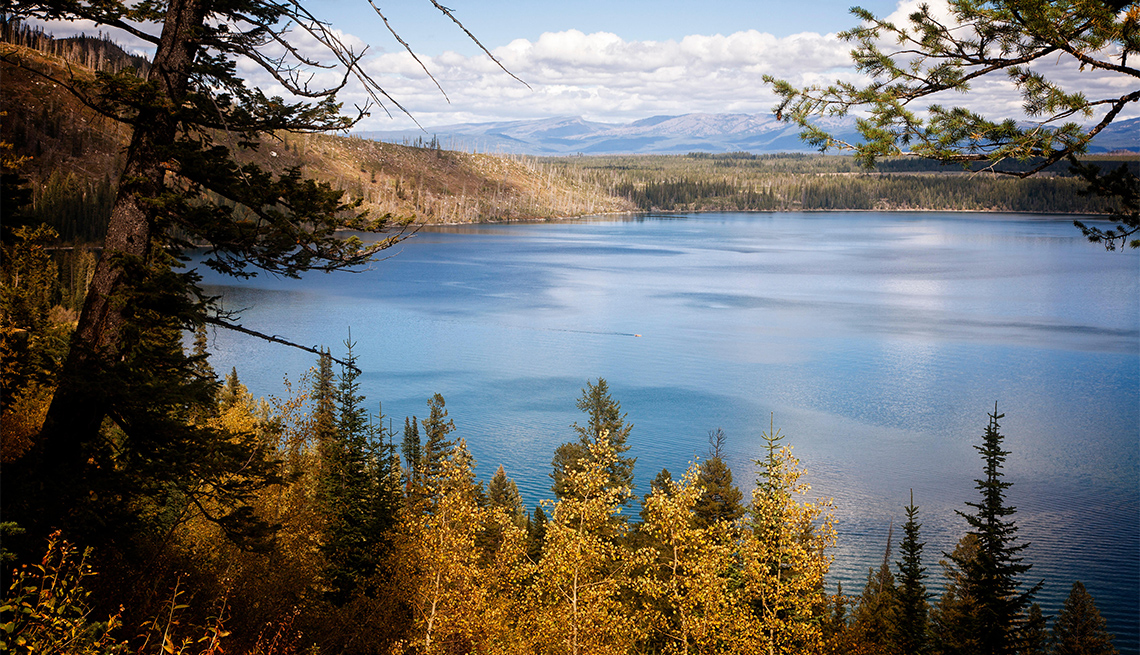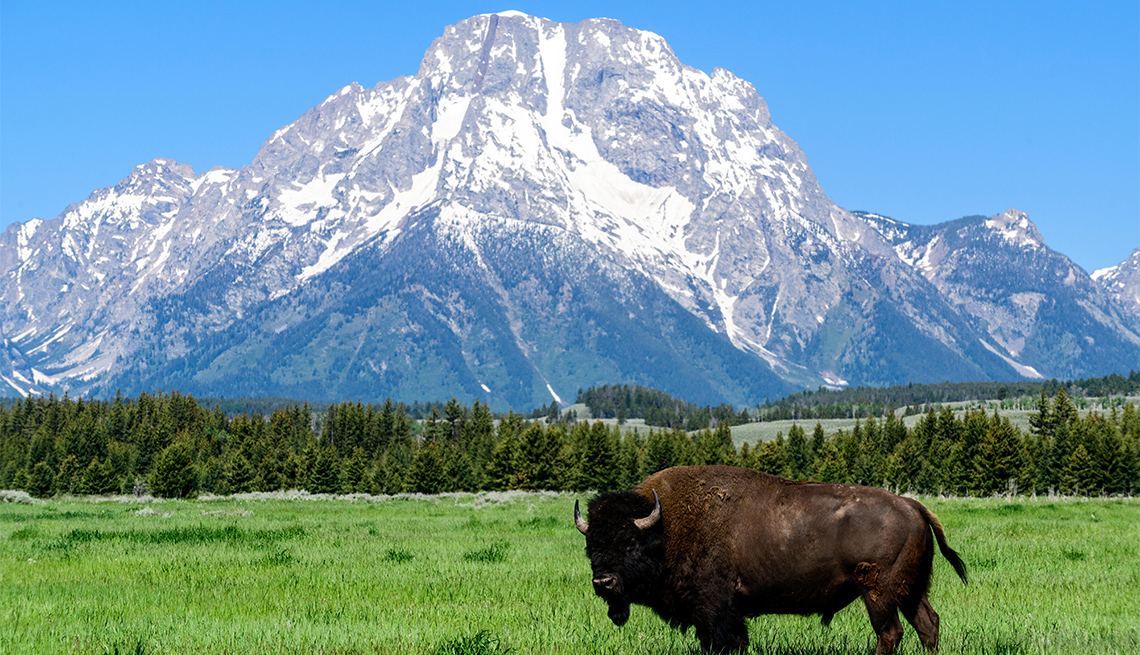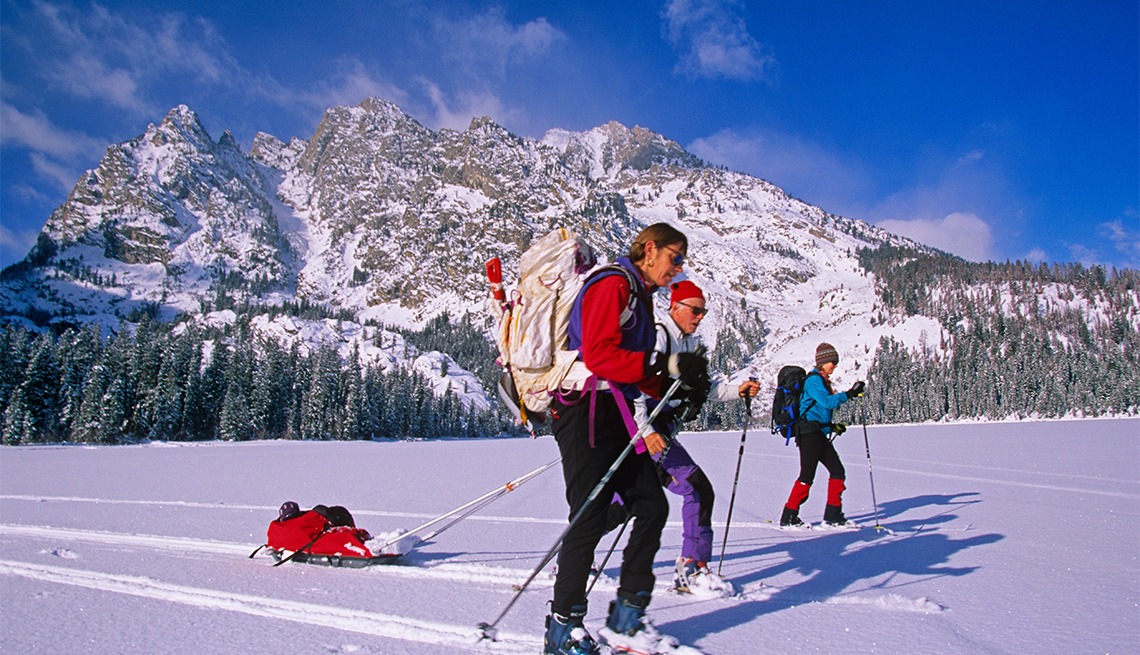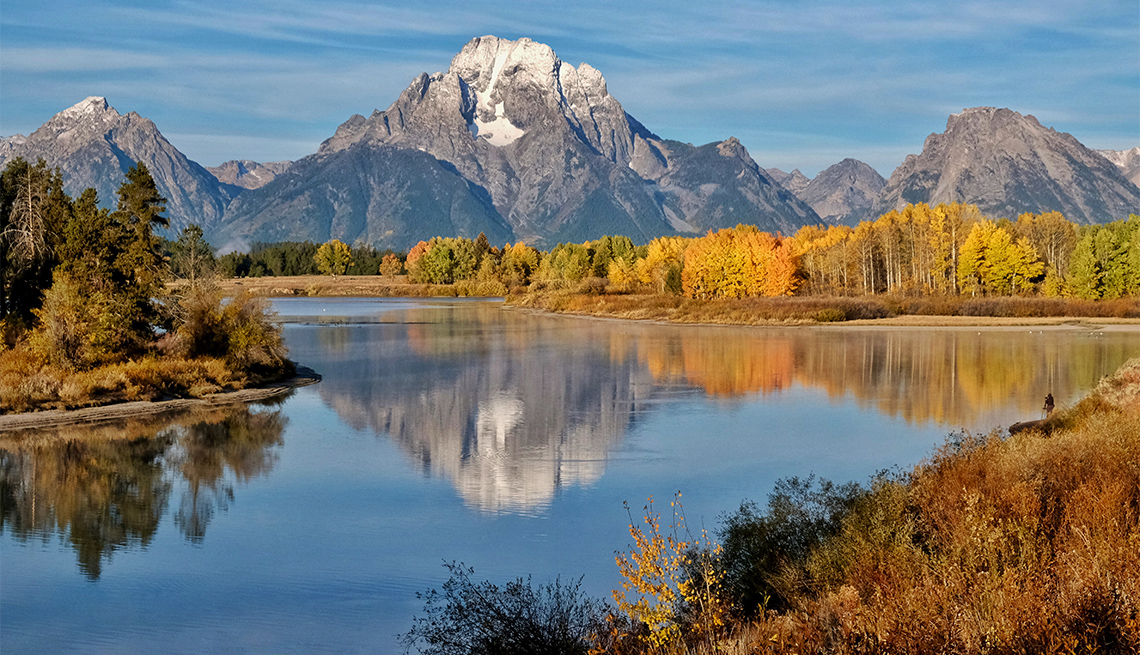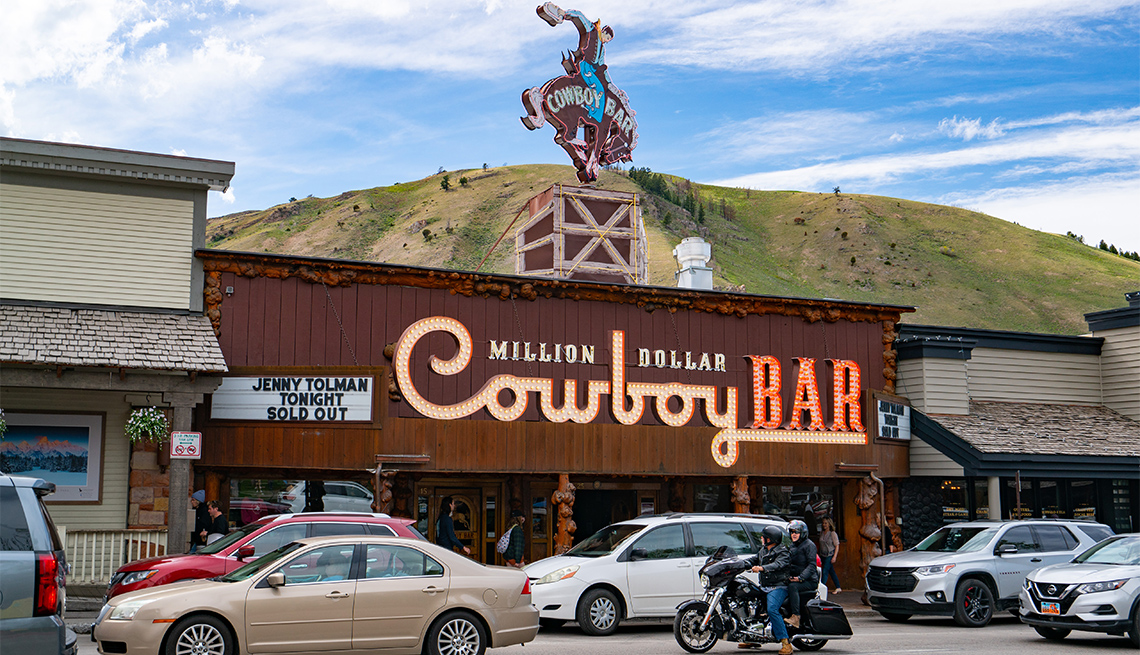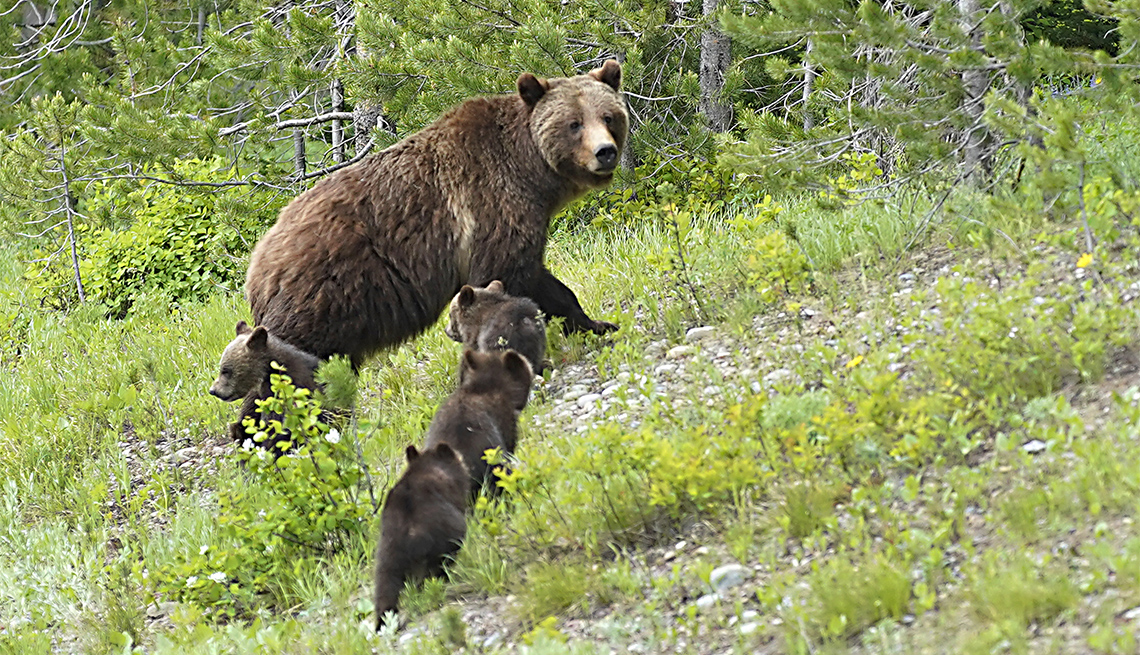AARP's Guide to Wyoming's Grand Teton National Park
Stunning snowcapped mountains, wildlife galore and more in this serene haven
En español | Other U.S. mountain ranges are taller, bigger and wider, but Wyoming's Tetons might be the country's most famous and most photographed. They rise, improbably dramatic and toothy, almost vertically from sagebrush flats to hulk 7,000 feet above the mighty Snake River and the surrounding valley of Jackson Hole. Often snowcapped until July — and home to a handful of small glaciers and year-round snowfields — the Tetons have as much subtlety as they do foothills, and they have no foothills. These mountains are the heart of the 310,000 acres that make up Grand Teton National Park (GTNP), just seven miles south of Yellowstone National Park.
Founded in 1929 and expanded in 1950 — thanks in large part to land donated by John D. Rockefeller Jr. — GTNP attracts more than 3 million visitors annually. While the Tetons’ stunning beauty remains the biggest draw, the park is becoming known as a wildlife-watching hot spot, too, with bears (black and grizzly), bison, elk, moose and wolves roaming its acres. And rock climbers test themselves on its multipitch granite buttresses, arêtes and ridges.
In winter, an average of 10 feet of snow transforms the park, burying hiking trails and lakes much to the delight of snowshoers and Nordic and backcountry skiers. From November through April, the park's hotels and restaurants close, as do many of its roads, giving it a quiet allure some can't resist. The backdrop of white often makes it easier to see the wildlife as well.
"Grand Teton National Park offers an abundance of year-round recreational and wildlife-viewing opportunities, and is enjoyable for all ages and abilities,” says Kristen Dragoo, GTNP park ranger and district interpreter for the Laurance S. Rockefeller Preserve.
Location: Wyoming's northwest corner, in the valley of Jackson Hole and immediately south of Yellowstone National Park
Area: 310,000 acres
Highest peak: Grand Teton, at 13,775 feet
Lowest point: Fish Creek, 6,320 feet, at the park's southern boundary
Trails: 242 miles of trails that connect to additional trails in the adjacent Jedediah Smith Wilderness and the Caribou-Targhee National Forest
Main attraction: The Teton mountains
Cost: $35 for cars (Annual Seniors Pass: $20 for 62 and older)
Best way to see it: Via short walks from the car
When to go to avoid the crowds: December to March are the least busy months of the year, but there are no park facilities open except for the Craig Thomas Discovery and Visitor Center. May and October are the least busy months when park lodges, visitor centers and restaurants are still open.
Plan Your Trip
Fly into the Jackson Hole Airport and you'll already be in the park. You might even spot your first moose before reaching the highway from the terminal. During the peak summer season, you can fly here nonstop from about a dozen U.S. cities, including Chicago (on United), Dallas (American) and Atlanta (Delta).
For a wider choice of flights, fly into Salt Lake City, about 300 miles south. From there, head east on Interstate 80 to Evanston, Wyoming, where you'll take U.S. Highway 89 north and drive through a vast high alpine desert, past the Wind River Mountains and up the Snake River Canyon to Jackson, the park's only true gateway town and the only incorporated one within an hour of any of GTNP's four entrances.
Drive 12 miles north of Jackson to reach the park's main entrance at Moose, home to a couple dozen people, a small post office and a few amenities. Or opt for the North entrance (coming from Yellowstone); the East entrance in Moran (another tiny community with a post office); or the Granite Canyon entrance in the southwest, one mile from the community of Teton Village.
To orient yourself, stop at the Colter Bay Visitor Center, in the middle of the park on Jackson Lake; the Jenny Lake Visitor Center, on the shore of its eponymous lake, the park's most visited spot, six miles from the Moose entrance; or the Craig Thomas Visitor and Discovery Center at the Moose entrance. You can get current trail and river conditions, find out the latest on wildlife sightings, and learn about the park's history and geology.
The interpretive center in the Laurance S. Rockefeller Preserve, a 1,106-acre refuge between the Moose and Granite Canyon entrances, has a different vibe from the visitor centers. “The Preserve Center is not like a traditional visitor center — it's smaller and encourages visitors to experience nature through our five senses,” says Dragoo. The preserve is limited to no more than 50 cars at a time, and the interpretive center is more about relaxing (Adirondack chairs line its front porch) than education.
June through September, the only months all park roads and facilities are open, are the busiest, and traffic can be heavy. But the wildflowers are blooming, hiking trails are snow-free and water activities abound on the lakes.
To visit the park when the facilities are open but the crowds are manageable, you'll have to take a chance on the weather. In May and October, the park gets less than one-third the visitors it does in July and August, and some lodges and restaurants are open. But you could find yourself in a blizzard if it's a snowy spring or fall. If it's a good spring or fall — no snow — you'll share the park with locals, who favor visiting during these two months.
To really avoid the crowds, come in the winter. In January 2020, the park attracted just 55,000 visitors, compared with 755,000 in July. Yes, you'll encounter road closures then — the Inner Park Loop Road is closed for 12 miles between the Bradley/Taggart Lakes trailhead and Signal Mountain — but the Tetons are even more striking when spackled with snow. Park lodges and restaurants are closed then, but those in Jackson are open.
You'll have cell service in most of GTNP, but the signal is rarely movie-streaming-strong, and most lodges have Wi-Fi. The visitor centers have restrooms, as do Jackson Lake Lodge, Leeks Marina and Signal Mountain. Pullouts along park roads have vault toilets.
Where to Stay and Eat
At Jenny Lake Lodge, the park's most luxe lodging option, a stay in one of its 37 cabins dating from the 1920s and ‘30s comes with daily breakfasts, happy hours and five-course dinners; horseback rides with lodge wranglers; the use of cruiser bikes; and easy access to several hiking trails. What you won't get: TVs or telephones in your cabin.
North of Jenny Lake, choose from three properties on or near Jackson Lake, GTNP's largest.
At Signal Mountain Lodge, which sits on the lake near its south end, 79 rooms are divided among 25 buildings. Or opt for one of the lodge's 28 suite-style Lakefront Retreats and you'll be sleeping as close to any GTNP lake as possible without schlepping camping gear into the backcountry.
Colter Bay Village, also on the lake, has no lakeside rooms, but it does have a marina. Its 166 log cabins, many built by valley homesteaders, were relocated here from around the valley on John D. Rockefeller's orders. Some have en suite bathrooms; others require using communal bathrooms. Book one of the property's 156 tent cabins and you'll need to bring your own sleeping bags or linens.
The 385-room Jackson Lake Lodge, about a half-mile from the lake and made of log and stone, blends into the surrounding landscape.
All four lodges have dining options, with Jenny Lake Lodge's dining room serving the park's best breakfast and dinner (currently open only to lodge guests).
GTNP's five campgrounds and one RV park offer more than a thousand sites scattered throughout the park. The Colter Bay, Jenny Lake, Lizard Creek and Signal Mountain campgrounds and the Colter Bay RV Park are near lakes; the Gros Ventre Campground lies near a river in sagebrush flats beneath massive cottonwood trees. Jenny Lake's is tents only, but the others can also accommodate RVs, with electrical hookups available at all but Lizard Creek. All six campgrounds require advance reservations (recreation.gov), with nightly rates from $18.50 to $98.
Some campers favor Gros Ventre, the park's largest campground, with 279 sites, since it's only about 11 miles from the town of Jackson. In the fall, its cottonwoods produce some of the valley's best colors.
Outside the park, take your pick from dozens of lodging options — hotels, motels, inns, resorts. Don't expect bargains, though. In summer, rates at even no-frill properties start at more than $300.
For lodging in Jackson, go basic at the 155-room Motel 6 or get cozy at boutique properties such as the 22-room Alpine House or the nine-room Inn on the Creek, both nestled into downtown side streets. For something contemporary, settle into the just-opened Cloudveil, a 100-room boutique hotel on the Town Square with a carefully curated library of books about the area and the West.
Come mealtime in Jackson, the Bistro restaurant at the Cloudveil serves up French brasserie-inspired dishes for breakfast, lunch and dinner. And even though you're in Wyoming, don't write off its oyster bar. Try the St. Germain Oyster Shooter, with St. Germain liqueur, lemon, sparkling rosé, caviar and an oyster served up in a shot glass. For south-of-the-border cuisine, head to Pica's Mexican Taqueria, a local favorite for its huge portions and strong margaritas.
In Teton Village, at the base of the Jackson Hole Mountain Resort and one mile from the park's Granite Canyon Entrance, pamper yourself at the Four Seasons Resort and Residences. The Continuum isn't just a hotel with 83 clean, modern rooms, but also a partnership with Teton Gravity Research (TGR), the Jackson Hole-based action movie company. As a result, photos of skiers and surfers from TGR movies are scattered throughout the hotel, and a giant TV in the lobby continually shows TGR movies.
When you get hungry, head to Il Villaggio Osteria for house-made pizzas and pastas. Order burritos, rice bowls and tacos at Tin Can Cantina, a food truck permanently parked at the base of the Bridger Gondola.
Things to Do
Go for a scenic drive. A 43-mile loop that winds along the foot of the Teton range, passing numerous overlooks, is split into two roads: the Inner Park Loop Road, which requires you to pay the park's entrance fee, and Highway 26/191/89 (commonly called the Outer Park Loop Road), a major Wyoming thoroughfare outside the park's entrances that's free to drive.
On the outer road, don't bypass the Snake River Overlook. Photographer Ansel Adams shot his famous 1942 photo, The Tetons and the Snake River, somewhere close to here. Explore shorter scenic drives that branch off the inner road. The four-mile, mostly one-way Jenny Lake Scenic Loop runs along the northeast shore of its namesake lake. At its many pullouts, admire the reflections of the snaggly peaks above. Take the five-mile Signal Mountain Road up to the mountain's 7,727-foot summit for the best views of the Tetons, which lie about 10 miles west.
View wildlife. Since 2007, the sow grizzly known as #399 has raised her litters in proximity to roads in the park's northern section, usually off the highway between Jackson Lake Lodge and Lizard Creek. One of her daughters, #610, has also raised her cubs in this area.
You'll likely spot moose on Moose-Wilson Road near the park's Moose entrance. The Grand Teton Bison Herd, about 600 strong, usually grazes in the sagebrush fields off Antelope Flats Road near the Gros Ventre Campground or in the open fields near the Elk Ranch Flats Turnout on the Outer Park Loop Road, two miles south of the Moran entrance.
Stay at least 100 yards away from grizzly bears and wolves and 25 yards from other wildlife.
Get active. Between November and May, when snow buries GTNP, strap on snowshoes or cross-country skis and glide across the 12 miles of the Inner Park Loop Road, closed to cars in winter, and the flats around the road. Rent the necessary gear from Skinny Skis or Teton Mountaineering in Jackson.
GTNP's summers are short but sublime, especially for hikers and road cyclists, although most of the park's 242 miles of trails are strenuous, with significant elevation gain. “The scenic vistas are breathtaking and inspirational, with the bonus of hiking's health benefits,” says Dragoo.
For a mellow, wheelchair-accessible walk, explore the 10 miles of paved pathways at the base of the mountains between the Craig Thomas Discovery and Visitor Center and Jenny Lake's southern end. They wind through sagebrush and wildflowers, with the Tetons rising just to the west.
Although not wheelchair-accessible, the eight miles of trails in the Laurance S. Rockefeller Preserve require only the same level of fitness you need for a walk around your neighborhood (but remember you're at about 7,000 feet elevation, with less oxygen in the air). They take you to Phelps Lake, which stands sentinel at the mouth of Death Canyon.
Wherever hiking in GTNP, carry bear spray and know how to use it. (Some visitors have sprayed themselves with it, like bug spray. Don't do that.)
Scale a mountain. Climb the 13,775-foot Grand Teton as part of a three- or four-day guided course by Exum Mountain Guides or Jackson Hole Mountain Guides. Surprisingly, climbing experience isn't required, just experience hiking at high elevations. Age isn't an automatic deterrent either. “I have seen 60-year-olds do way better than 20-year-olds. I have found that, more than fitness or age, motivation, mindset, the ability to hear and follow instructions, and grit are better at determining one's success,” says Janelle Smiley, a climbing guide with Exum Mountain Guides.
Guide services offer half- and full-day climbing adventures, too. Or just enjoy the scaling vicariously at Dornan's Bar in Moose, where two walls of windows deliver perfect views of climbers reaching the Grand's summit. Bartenders lend binoculars.
Hit the water. Go rafting on a 10-mile stretch of the Snake River where there's no whitewater, so your trip will be more about scenery and wildlife than getting soaked and experiencing an adrenaline rush — and you won't be expected to paddle. “If you can sit on a couch, you can do our float trip,” says Grant Bishop, a guide with Barker-Ewing Scenic Float Trips for more than 20 years.
Barker-Ewing's floats start and end near the Moose entrance. Grand Teton Lodge Company picks up and drops off its riders at the Jackson Lake Lodge.
GTNP also has more than 100 alpine lakes accessible only by foot or horse, and two drive-to lakes (Jackson and Jenny). Rent anything from kayaks to motorboats at Jackson Lake marinas, where you can also take scenic cruises. To paddle on Jenny Lake, rent a kayak or SUP at Dornan's, or take Jenny Lake Boating's passenger ferry between the hiking trails on the lake's east and west shores.
Learn about the Native American tribes associated with the park. Humans have used this land for at least 11,000 years, and 24 Native American tribes have ties to it. The park's David T. Vernon Collection includes art and artifacts from more than 100 tribes, including many that hunted seasonally in the area. While the majority of the collection is preserved in storage, the park displays several dozen items at the Craig Thomas Discovery and Visitor Center and the Colter Bay Visitor Center in exhibits that change every couple of years.
Annually between late May and late September, Colter Bay hosts Native American artists for weeklong residencies. They work in a variety of media (beads to oil paint and photography), interact with visitors and sell finished pieces.
AARP Membership -Join AARP for just $12 for your first year when you enroll in automatic renewal
Join today and save 25% off the standard annual rate. Get instant access to discounts, programs, services, and the information you need to benefit every area of your life.
Gateway Towns
Jackson. As the area's biggest community (population: 10,500), Jackson is on the fast track to getting very fancy, with new luxury hotels and upscale restaurants, but it's working hard not to completely lose its rustic roots. For example, Alison and Kevin Cohane, the married founders of the popular Persephone Bakery Café, opened their French-inspired bakery in a 1920s log cabin, then followed that venture in 2020 with Coelette, located in a 1915 log cabin. The latter's dinner menu features dishes inspired by ingredients and techniques from mountain regions around the world, such as French rillettes — walnut rye toast topped with pork from a local ranch. Although art galleries and real estate offices line the Town Square, it's also home to a nightly (staged) shoot-out in summer.
You'll want to explore these smaller communities as well.
Kelly. The Grand Teton Bison Herd hangs out near this small community in GTNP about two miles from the Gros Ventre Campground. The lone cafe, Kelly on the Gros Ventre, serves delicious made-to-order sandwiches. A favorite: Guide the Grand, basically a roast beef club with a BLT in the middle.
Moose. Yes, you can often see moose in Moose. Every Monday from 6 to 9 p.m., soak up some local flavor at Dornan's Hootenanny, an anything-goes open-mic session featuring everything from folk music to yodeling.
Teton Village. This village sits at the base of the Jackson Hole Mountain Resort, less than two miles south of the park's Granite entrance. Ski here in winter; in summer, take in a chamber music or orchestra concert at the Grand Teton Music Festival, which runs for seven weeks.
Wilson. At the base of Teton Pass, hang with locals at the Stagecoach Bar, a beloved roadhouse opened in 1942, or at Pearl Street Bagels, where you can grab fresh-baked bagels and coffee drinks. For grocery items or locally made chocolates, drop into Hungry Jack's general store.
En Route
Between December and early March, in the 13 miles that separate Jackson from Moose, take a horse-drawn sleigh ride through the National Elk Refuge, a 24,700-acre preserve where about 7,000 elk spend the winter. The hourlong rides depart daily from the Jackson Hole & Greater Yellowstone Visitor Center, several blocks north of Jackson's Town Square. “To get so close to these animals, and to learn about them and the many other animals that live on the refuge from the naturalist driver, is a one-of-a-kind experience,” says Barbara Gentry, a 20-year Jackson resident and concierge at the Cloudveil.
On a butte overlooking the refuge, the National Museum of Wildlife Art showcases works by the likes of John James Audubon and Georgia O'Keeffe.
Good to know. Only seven miles separate Yellowstone National Park's southern entrance and GTNP's northern entrance. Because these seven miles are also part of the National Park Service — the John D. Rockefeller Memorial Parkway — the two parks almost seem adjacent to each other, so most people combine them in one trip.
- |
- Photos

